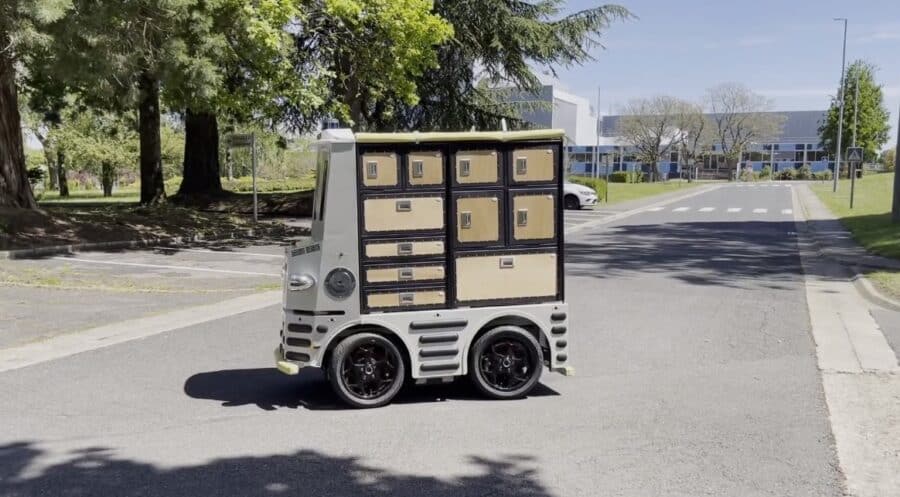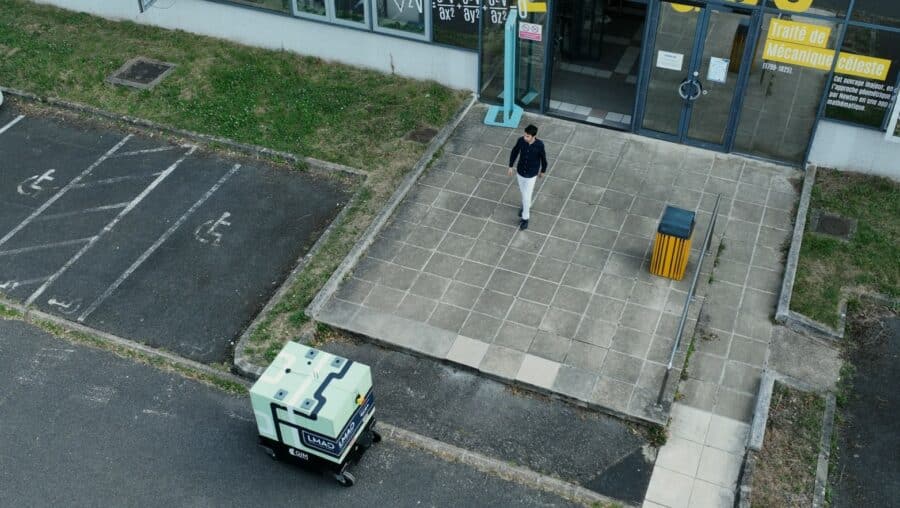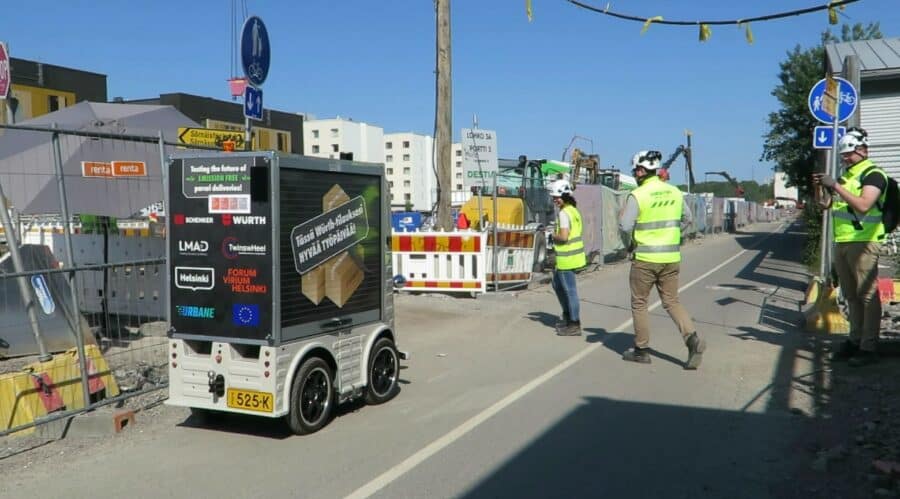On-site delivery at industrial campuses: What are the options and how do autonomous robots fit in?
Delivery robots are slowly becoming a more common sight in urban areas: Experiments and commercial deployments are becoming reality in many cities, not only in North America and in Asia, but even in Europe. For example, we have managed multiple experiments in Helsinki (including the last one in Kalasatama in the summer of 2023 and a previous one in Jätkäsaari in the winter of 2021-2022).
What’s the current state of deliveries at industrial sites, however? Aren’t private campuses the perfect location for experimentation with autonomous robots and vehicles? What other delivery methods are typically used?
Although on-site deliveries at industrial campuses is a topic less often talked about, it’s equally important for the future of automation. Private sites offer a lot of possibilities for conducting pilot tests without the usual administrative hurdles – authorities are generally hesitant to grant permits for the use of sidewalks or roads by robots in already busy cities – and are therefore an ideal playground for experimentation.
In this article, we’ll look into the different options available for on-site delivery and see how robots fit into this context.
What are the options for on-site delivery and transportation at industrial sites?
There are many options for on-site delivery at industrial sites, depending on the type of goods to be delivered, the frequency, the particular logistics and size of the site, the buildings and their layout, and, of course, the number of people working at it. Here are some possible options:
- Trucks and vans: This is one of the most common forms of delivery. Trucks of different sizes can be used, from small vans to full-sized semi-trucks, depending on the volume of goods. Different companies are making progress in the automation of trucks and vans, but in most cases, the middle mile is a much easier use case than the last mile of delivery.
- Drones: Drones are becoming increasingly popular for small deliveries that need to be made quickly. They can deliver items on large campuses faster than when using ground transportation.
- Automated guided vehicles (AGVs): AGVs, such as forklifts, tuggers, and pallet trucks, are often used in factories or warehouses to transport heavy loads. They can operate on pre-programmed routes or be guided by floor wires, magnets, lasers, or vision cameras.
- Autonomous robots and vehicles: Contrary to AGVs, autonomous robots and vehicles don’t need additional infrastructure (such as magnets or wires) to move from A to B. Rather, they can do that autonomously, once they have been trained on the possible routes they can take. Autonomous robots can be used both indoors and outdoors, while autonomous vehicles (cars, vans, or trucks) most commonly move outdoors. Users can summon them with the help of a mobile application and also get real-time updates on their location.
- Human-powered transport: For some use cases (short distances, light payloads), human-powered transport such as bicycles and push-carts might still be a convenient option.
- Rail systems: Some industrial campuses are large enough to have their own internal rail systems. These can move large quantities of goods and heavy loads but infrastructure costs are high.
- Conveyor systems: To continuously move materials around a manufacturing or distribution site, a conveyor system could be used. Conveyors can be automated and timed precisely, which makes them ideal for assembly line processes.
- Pipelines: In certain industries, pipelines are used to transport raw materials or finished products across industrial campuses.

Our robot during our experiment with EDF in the Paris region
The choice of delivery method depends on factors such as:
- The size of the campus
- The nature of the goods to deliver
- The available budget
- The deliveries’ urgency
- The available infrastructure
- Specific operational needs
What are the benefits of using autonomous robots and vehicles for on-site deliveries at industrial campuses?
Autonomous robots and vehicles are convenient for on-site deliveries for users and organizations alike for several reasons. Let’s look into the details:
- Sustainability: Autonomous robots are electric, which can help reduce the carbon footprint of a facility. On average, any electric vehicle produces less than 2% of the CO2 emissions of vans with internal combustion engines. Robots also don’t pollute the air locally, which further helps reduce the environmental impact of industrial sites.
- Efficiency: Autonomous robots can operate continuously without needing breaks (except for battery recharges).
- Convenience and ease of use: Last-mile delivery robots can deliver parcels to employees at a convenient time and location, thus reducing the disruption of their work and increasing productivity. Rescheduling is also easy with the right software system (which is one of our key focus points).
- Resource allocation: By automating delivery tasks, employees can be reassigned to tasks that require human skills, such as problem-solving, strategic planning, or customer service.
- Reduced costs: Although the initial investment (into the robots, systems, and setup) can be high, in the long run, robots can help reduce costs for gas or labor, for example.
- Data and insights: In addition to the previous point, autonomous robots can collect data from the campus, which can then be used to optimize operations, identify potential issues (including safety hazards), and make more informed business decisions.
- Scalability: After the initial setup phase, autonomous delivery systems can be easily scaled up or down to meet demand. A single larger robot can be used to deliver parcels to a predefined location where it meets a few smaller robots that deliver goods to individuals.
- Flexibility: Organizations can reprogram and redirect robots as needed, which gives a high degree of operational flexibility. Additionally, robots can do multiple tasks, from delivering parcels to letters or even hot meals and even to monitoring sites for intruders or unusual activity.
Nevertheless, it’s important to consider that the implementation of an autonomous delivery solution may require a significant investment and efforts related to the cost of robots, employee training, ongoing maintenance and upgrades, and any eventual infrastructure modifications. So, it’s important to make a careful assessment of the costs and benefits.
Pilot experiments are ideal for this, as they enable businesses to explore different automation processes and technologies before committing to a large deployment. In fact, we believe that now is the perfect time to start experimenting with delivery robots – and have been assisting companies in managing experiments on industrial sites for the past few years.
Our experience: What we’ve learned from our experience with autonomous delivery at industrial campuses (EDF and Nokia)
We’ve worked with EDF and Nokia on industrial campuses in the Paris region to provide them with a viable robot-assisted solution to traditional parcel distribution methods.
During our collaboration with Nokia, our platform was used to fully automate the last mile of the delivery process with the help of a robot created by the Finnish company GIM Robotics.
In our work with EDF, our approach was similar (with a different robot, built by the French company TwinswHeel) – and we also started to work on a second use case, for on-site surveillance. For this use case, we’re doing a test deployment in which the robot helps monitor the site over a 24-hour period.
The goal of both experiments was to provide a proof of concept for autonomous delivery at an industrial site and give Nokia and EDF a viable and cost-efficient alternative to traditional distribution methods. Standard delivery so far meant that employees needed to come and collect their parcels themselves at a delivery center (which is disruptive to their work).
In both instances, our robots delivered small parcels: up to 5 kg in the case of Nokia and up to 25 kg in the case of EDF.
In those experiments, we demonstrated that robot-assisted deliveries can:
- Provide more convenient deliveries: Employees could receive deliveries in front of the office buildings where they worked instead of needing to go to the distribution center. This enabled employees to save time and be more productive.
- Enable easy communication and rescheduling: Employees could see the status of their deliveries, receive real-time updates, reschedule times, and change pickup locations through our interface, which helped lower the number of missed or late deliveries.
- Facilitate the work of the logistics provider: By automating a portion of their delivery process, the logistics provider could simplify and streamline their work and, ultimately, provide a better service.
Regarding the last point, with the help of LMAD, the on-site logistics provider with whom we partnered, Sodexo, managed to achieve the following:
- Save a lot of time by not delivering small parcels that had a high missed-delivery rate
- Deliver parcels that they previously struggled to deliver due to lacking customer data
- Extend delivery hours to mornings and afternoons (rather than just afternoons, as they did previously) – the robot could deliver parcels all day long

LMAD’s robot at Nokia’s campus in the Paris region
In addition to that, at EDF’s site Les Renardières, we explored ways to improve security during nighttime, which was also our second use case.
Nokia and EDF didn’t need any additional authorizations to conduct these experiments, because in both instances they took place on their campuses, which are private.
This proves, once more, that industrial sites are an ideal location for companies that wish to conduct experiments with autonomous robots and explore the technology’s capabilities and different ways it can be integrated into processes.
In our last experiment in Helsinki, our robot delivered tools and supplies from a Würth Center to construction sites nearby. This involved:
- Using public sidewalks
- Navigating through construction zones that changed on a daily basis
This increased the complexity of the task but helped demonstrate the flexibility of our solution.

LMAD’s robot during our latest experiment in Helsinki in 2023
Autonomous deliveries on private sites vs. deliveries via public roads
Having gained a lot of experience with both types of autonomous deliveries, on public roads (in urban areas, mainly in Helsinki) and on private sites (at EDF’s and Nokia’s campuses), we can confidently say that setting up autonomous deliveries is generally easier in a private industrial campus.
Public locations offer the benefit of a wider operating area but they also come with an added layer of complexity because of the necessary authorizations and the fact that more users share them, making them significantly less predictable and more challenging.
When it comes to private campuses, they offer the following advantages for experimentation with new delivery technologies, such as autonomous robots:
- Less traffic: Traffic at industrial sites is usually way less dense and complex, which means it’s also easier to navigate for autonomous vehicles and robots. There are fewer unpredictable elements (like road works or erratic drivers, for example), simplifying navigation.
- No (or few) authorization requirements: Current regulations for autonomous robots vary significantly in different countries and navigating them can be complex. Experiments in public areas typically require a number of permits, which isn’t necessary in private campuses.
- Better control over the infrastructure: On a private industrial site, the company has full control of the infrastructure and can make modifications to facilitate autonomous deliveries, if needed (f.e. setting up charging stations, loading areas, and more).
Autonomous robots present lots of opportunities to streamline on-site deliveries
Industrial sites provide a fertile ground for experimentation with different types of automation, including autonomous delivery systems.
Manufacturers have long been using different types of automation technologies, such as guided vehicles (f.e. forklifts) or conveyor systems to speed up operations and make them more efficient, but automating the parcel delivery to employees at large sites (spanning hundreds of hectares) remains relatively unexplored.
Innovative organizations like EDF and Nokia have successfully started venturing into it to explore new ways of simplifying operations and improving employee productivity – and we’re convinced that the right time to do this is now.

